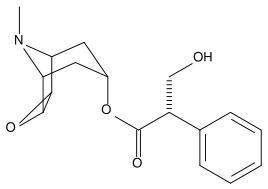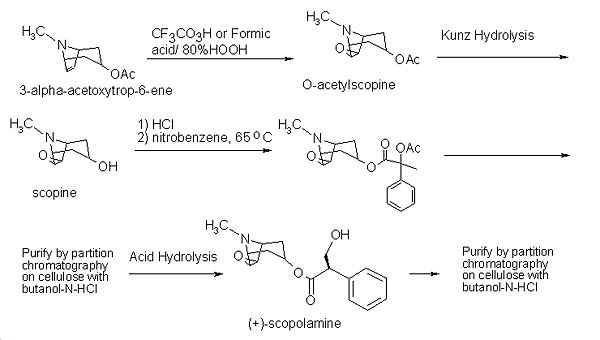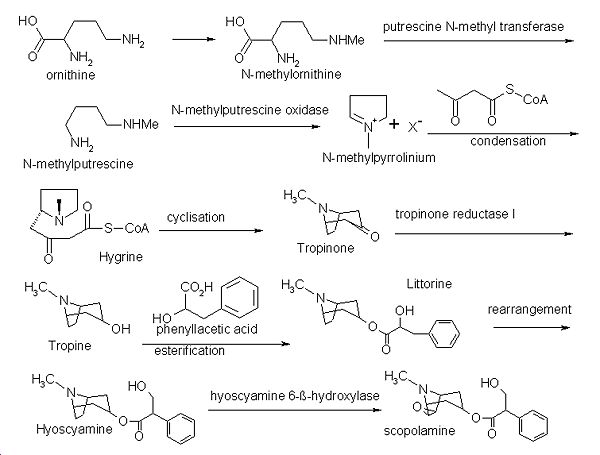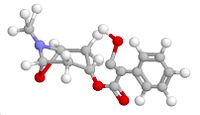It07:Hycocine
Hyoscine
Hyoscine (hī′ə sēn′, sin), also known as scopolamine, is a tropane alkaloid drug extracted from the nightshade family of plants that affects the autonomic nervous system and prevents muscle spasms. It is normally used as an anti-motion sickness drug. The active ingredient is hyoscine hydrobromide, which also dries up fluids in the body, hence its use to dry up secretions in the nose, lungs and throat.
The molecular formula for hyoscine is C17H21NO4. Molecular mass, 303.353g/mol; pKa, 7.55-7.8.
The systematic name is [7(S)-(1a, 2b, 4b, 5a, 7b)]-a-(Hydroxymethyl)benzeneacetic acid 9-methyl-3-oxa-9-azatricyclo non-7-yl-ester. Other names for it include Benzenacetic acid, a-(hydroxymethyl)scopolamine, scopine tropate, tropic acid ester with scopine, L-scopolamine, and 6,7-epoxytropene tropate. Trade names include Buscopan, Hyospasmol, Lotanal, Oportunin, Scop, Scopoderm T, and Spasmofen.
Hyoscine is the (-)-scopolamine enatiomer. It is a heterocyclic compound and has a single chiral centre attached to a MeOH group. The two enatiomers are biologically similar but chemically distinct. They can be separated by chromatography, or melting points, though they both show the same NMR spectra. It is usually stored as a hydrated hydro-halogen salt, as this provides stability for the easily decomposed compound. It has weak acidic properties though the methylated nitrogen readily accepts hydrogen.

Image of Hyoscine
Crystal structure (unit cell)
Hyoscine |
How it works as a travel sickness drug
The vestibular system, which comprises of 3 liquid filled tubes situated in the inner ear, sends messages to the brain about the motion of our body (weather we are being moved around or are stationary). The brain also receives information about weather we are moving or not from our eyes. When the two senses send conflicting messages travel sickness can occur. Hycoscine blocks the messages from the vestibular system and stops them reaching the ‘vomiting centre’ in the brain. This is the centre which co-ordinates the vomiting reflex. Hycoscine blocks the muscarinic receptors in this centre and thus prevents them from sending nerve messages to the stomach and inducing vomiting. This is most effective if the drug is taken before travel, although how far before varies from product to product. Generally patches need to be applied 5-6 hours before whereas tablets usually only need to be taken 30 minutes before. However one unfortunate side effect of the drug is that it may cause drowsiness and burred vision. Not ideal for someone wishing to drive! Reference; http://www.netdoctor.co.uk/medicines/100005066.html
Side Effects
Common side effects include; Dizziness Dry mouth, throat and nasal passages Blurred vision Drowsiness Problems with urinating Constipation Sensitivity to light Thirst
Signs of overdose include; Lethargy Coma Confusion Agitation Hallucinations Convulsions Visual disturbance Dry flushed skin Tachycardia Hypertension Paralysis Temporary blindness Supraventricular arrhythmias Urinary retention Decreased bowel sounds
History
One of the side effects of this drug is that, in larger doses it can cause people to become very docile and immune to pain. Throughout history this has been taken advantage of. It is currently used as a sedative to treat post operative nausea and causes amnesia. Hycoscine, also known as Scopolamine is naturally produced by a tree known as borrachero and can be extracted from the seeds. Translated borrachero mean ‘get-you-drunk’ . It grows naturally in Colombia. There is a local legend that Colombian Indian tribes drugged the wives and slaves of fallen chiefs with scopolamine so they would ‘accompany them into the after world quietly’ i.e. allow themselves to be buried alive! It was also used in the early 20th century to help mothers through childbirth. During world war II Joseph Mengele, an infamous Nazi war criminal, used Scopolamine as an interrogation drug.
Crime
Currently in Colombia Scopolamine is cheaply and readily available both in processed form from neighbouring Equador (where it is available over the counter for travel sickness) and from local plants. This has caused a large problem for the police. Scopolamine is odourless, tasteless and colourless hence it is very easy to slip into drinks and sprinkle over food undetected. Only a small amount needs to be consumed for a very drastic effect as the drug is very potent and highly toxic. For example in treatment of travel sickness a typical dose will be 0.33 milligram of scopolamine per day. This will be administered slowly via a patch. When larger amounts are consumed Scopolamine can completely block the formation of memories and cause temporary blindness. It also acts as a strong sedative and makes the consumer very docile and co-operative and in larger doces can cause paralysis and dillusion. Hence it is obvious why it has become so commonly used by thieves and rapists. According to Colombian Hospitals and Police, in most cases it scopolamine used as a date rape drug. As no memory of the incident is ever formed, victims cannot identify their attackers, even under hypnosis. They also cannot testify against them in court as they have non memory of what happened. This means that unfortunately attackers are never found. As the victims are so submissive under the influence of the drug, they often help the attackers to rob them, giving them access to their bank accounts, allowing them to take their things and even telling people not to stop them. One example is Andrea Fernandez, who under the influence of the drug allowed a gang of infant traffickers to take her baby from her, rape her and repeatedly beat her. It is not only women, commonly drugged then rented as prostitutes, who suffer from spiking with scopolamine. US Embassy and government officials are given special advice on how to avoid being drugged before they enter Colombia. Despite this visiting officials have been drugged more than 3 times in recent years. One told his doorman to allow his attackers to walk out of his hotel with all his belongings including confidential US government documentation! However the illegal use of Scopolamine, whilst very commonplace in Colombia, thankfully seems to be almost unheard of in other parts of the world, despite it being and extraordinary aid to crime. Reference; http://www.biopsychiatry.com/scopolamine/borrachero.html
Routes of Synthesis
There are 3 routes from tropane-3а 6в-diol, all resulting in 3-alpha-acetoxytrop-6-ene. This can then be converted to hyoscine by removal of the Ac group via Kunz hydrolysis, followed by treatment with HCl and nitrobenzene. This yields O-acetylscopolamine. Acid hydrolysis results in the removal of the acetyl group and conversion to (+)-hyoscine. The synthesis of hyoscine does however produce many byproducts.
Hyoscine is also obtained from biosynthesis in plants of the genus Datura. Generally it is synthesised in the roots of young plants and accumlates in the aerial regions. The biosynthesis is controlled by numerous enzymes in the plant, such as tropinone reductase I and hyoscyamine 6B -hydroxylase.
Mechanism for the conversion of 3-alpha-acetoxytrop-6-ene into hyoscine

Mechanism for the biosynthesis of hyoscine


